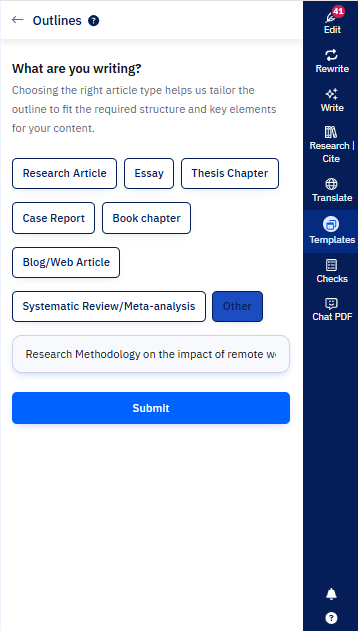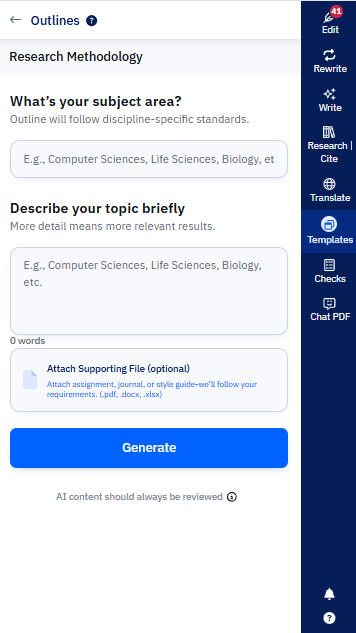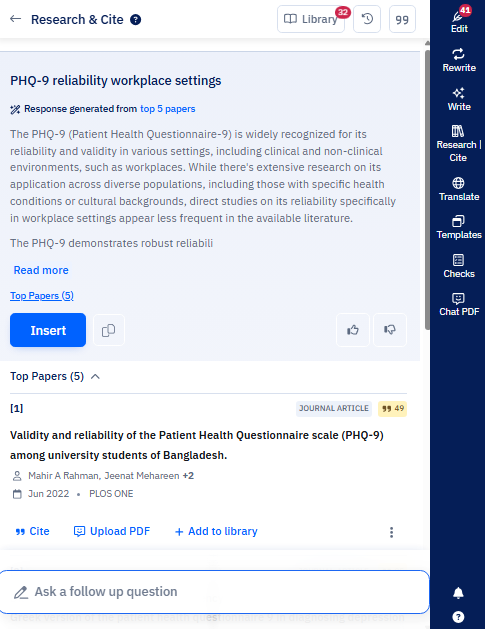Table of Contents
Research methodology is a structured and scientific approach used to collect, analyze, and interpret quantitative or qualitative data to answer research questions or test hypotheses. A good research methodology answers your research questions ethically and clearly explains why you made each methodological choice. If your study were repeated under similar conditions, your research methodology should act as the foundation for other researchers to verify your findings, build on your work, or determine if your results hold in different contexts.
In this article, let’s explore the basics of methodology sections and how to write a research methodology with Paperpal.
What is a Research Methodology and Why is it Important?
A research methodology is your plan for how you’ll conduct your study. It explains:
- What methods will you use to collect information (surveys, interviews, experiments, etc)
- How will you analyze that information
- Why did you choose these particular approaches
Think of it as your research roadmap, outlining the step-by-step process for answering your research questions. A research methodology includes research design, data collection methods, data analysis methods, and the overall framework within which the research is conducted.
Having a good research methodology in place has the following advantages:
- Helps other researchers with enough details to follow your exact steps and reproduce your study
- Justifies your approach towards making methodological choices, if questions arise at a later stage
- Provides a foundation for researchers to clearly define research questions, hypotheses, and objectives
- Identifies the most appropriate research design, sampling technique, and data collection and analysis methods
- Ensures reliability in findings that other researchers can trust and reduces ambiguity in the form of biases and errors

What Does a Research Methodology Include?
A research methodology should include the following components:
- Research design should be selected based on the research question and the required data. Standard research designs include experimental, quasi-experimental, correlational, descriptive, and exploratory
- Research method can be quantitative, qualitative, or mixed-method.
- Reason for selecting a specific methodology explains why this methodology is the most suitable to answer your research problem
- Research instruments explain the data collection methods, such as interviews, surveys, etc. You need to specify why you chose a particular instrument
- Sampling involves selecting a representative subset of the population being studied.
- Data collection involves gathering data using your research instruments i.e. surveys, interviews etc.
- Data analysis describes the data analysis methods you will use once you’ve collected the data.
- Research limitations underline any limitations you foresee while conducting your research.
- Validity and reliability help identify the accuracy and truthfulness of the findings; reliability refers to the consistency and stability of the results over time and across different conditions
- Ethical considerations outline that research should be conducted ethically. The considerations include obtaining participants’ consent, maintaining confidentiality, and addressing conflicts of interest
How to Write a Research Methodology with Paperpal?
Writing a comprehensive research methodology can be time-consuming and complex. Paperpal streamlines this process by guiding you through each step, from initial structuring to final polish. Here’s how it works in practice.
1. Start with Paperpal Templates for Structure
For example, if your research topic is “The Impact of Remote Work on Employee Mental Health,” write a prompt or upload rough notes on Paperpal Outline that have your research design, data collection methods, research methodology type, and sampling size. Paperpal will create a structured research methodology outline based on your notes covering research design, sampling strategy, data collection, analysis methods, and ethical considerations.


2. Learn from Published Research with Chat PDF
Upload a published study on workplace mental health research to Paperpal’s Chat PDF. Get a detailed summary of the paper and ask specific questions like “What sampling technique did this study use?” or “How did they measure mental health outcomes?”. You can also look for related papers on the topic and save them to your library to read later. This helps you understand methodological best practices in your field and identify gaps your research can address.
3. Generate a First Draft with Write
Now upload your research notes—sample size (300 employees), chosen instruments (PHQ-9 questionnaire, semi-structured interviews), and sampling approach (stratified random sampling by department). Paperpal Write generates a complete first draft of each methodology subsection, from research design rationale to specific data collection procedures.
4. Validate Your Methodology with Research & Cite
Use the Research feature to find sources from 250 million research papers that validate your methodological choices. Review the top 5 relevant papers by reading their abstracts first. Then, decide whether to upload each PDF to ChatPDF for instant insights or save it to your library for later reading. If you want to cite it directly in your methodology, Paperpal automatically formats citations in more than 10,000+ citation styles, including APA, MLA, Chicago, etc.

5. Refine with Rewrite
Polish your draft using the Rewrite feature. Paraphrase text to make it more personalized, convert informal notes into academic language, condense verbose sections to meet word limits, and ensure technical terminology is used consistently throughout.
6. Final Polish with Grammar Checker
Polish your methodology section using Paperpal’s Edit. Unlike other grammar checkers, Paperpal understands academic writing conventions and doesn’t overwrite technical terminology with simpler words. Get subject-specific language suggestions that go beyond grammar and include technical vocabulary, formatting consistency, proper tense usage (past tense for procedures), and maintain consistency in terminology.
Types of Research Methodology
There are three types of research methodology based on the kind of research and the data required
- Quantitative research methodology focuses on measuring numerical data, testing hypotheses, identifying patterns, assessing correlations and cause-and-effect, and generalizing results to a larger population. Standard methods in quantitative research include surveys, questionnaires, experiments, statistical analysis, and structured observations with numerical coding.
- Qualitative research methodology examines people’s opinions, behaviors, and experiences. It collects and analyzes words and textual data. This research methodology requires fewer participants but is still more time-consuming because the time spent per participant is quite large. This method is used in exploratory research where the research problem being investigated is not clearly defined.
- Mixed-method research methodology uses the characteristics of both quantitative and qualitative research methodologies in the same study. This method allows researchers to validate their findings, verify whether the results obtained with both methods are complementary, and explain any unexpected results from one method using the other.
Sampling Designs Used in Research Methodology
Sampling in research methodologies involves selecting a representative sample of the population to conduct the study, making statistical inferences about it, and estimating the characteristics of the whole population based on these inferences. There are two types of sampling designs in research methodology: probability and nonprobability.
Probability sampling
A sample is randomly chosen from a larger population, i.e., every member of the population has an equal chance of being selected. The different types of probability sampling are:
- Simple random—every single member is chosen randomly.
- Systematic—sample members are chosen at regular intervals. It requires selecting a starting point for the sample and determining the sample size, which can be repeated at regular intervals. This type of sampling method has a predefined range; hence, it is the least time-consuming.
- Stratified—researchers divide the population into smaller groups that don’t overlap but represent the entire population. While sampling, these groups can be organized, and then a sample can be drawn from each group separately.
- Cluster—the population is divided into clusters based on demographic parameters such as age, sex, and location.
Nonprobability sampling
This involves feedback on a researcher’s sample selection capabilities, rather than a fixed selection process. The different types of nonprobability sampling methods are:
- Convenience—selects participants who are most easily accessible to researchers due to geographical proximity, availability at a particular time, etc.
- Purposive—participants are selected at the researcher’s discretion. Researchers consider the study’s purpose and the target audience’s understanding.
- Snowball—already selected participants use their social networks to refer the researcher to other potential participants.
- Quota—while designing the study, the researchers decide how many participants to include with which characteristics. The characteristics help in choosing people most likely to provide insights into the subject.
Data Collection Methods Used in Research Methodologies
During research, data are collected using various methods, depending on the research methodology and the methods being employed. Both qualitative and quantitative research have different data collection methods, as listed below.
Qualitative research
- One-on-one interviews: Help the interviewers understand a respondent’s subjective opinion and experience pertaining to a specific topic or event
- Document study/literature review/record keeping: Researchers’ review of already existing written materials such as archives, annual reports, research articles, guidelines, policy documents, etc.
- Focus groups: Constructive discussions that usually involve a small sample of 6-10 participants and a moderator to understand participants’ opinions on a given topic.
- Qualitative observation: Researchers collect data using their five senses (sight, smell, touch, taste, and hearing).
Quantitative research
- Sampling: The most common type is probability sampling.
- Interviews: Commonly telephonic or done in-person.
- Observations: Structured observations are most commonly used in quantitative research. In this method, researchers observe specific behaviors of individuals in a structured setting.
- Document review: Reviewing existing research or documents to collect evidence for supporting the research.
- Surveys and questionnaires. Surveys can be administered both online and offline, depending on the requirement and sample size.
Data Analysis Methods Used in Research Methodologies
Data collected using various qualitative and quantitative research methods must be analyzed to generate meaningful conclusions. These data analysis methods also differ between quantitative and qualitative research.
Quantitative research involves a deductive method of data analysis, in which hypotheses are developed at the outset and precise measurement is required. The methods include statistical analysis applications to analyze numerical data and are grouped into two categories: descriptive and inferential.
Descriptive analysis is used to describe the basic features of different types of data, presenting them in a way that makes the patterns meaningful. The different kinds of descriptive analysis methods are:
- Measures of frequency (count, percent, frequency)
- Measures of central tendency (mean, median, mode)
- Measures of dispersion or variation (range, variance, standard deviation)
- Measure of position (percentile ranks, quartile ranks)
Inferential analysis is used to make predictions about a larger population from data collected from a smaller population. This analysis examines relationships among variables. Some commonly used inferential data analysis methods are:
- Correlation: To understand the relationship between two or more variables.
- Cross-tabulation: Analyze the relationship between multiple variables.
- Regression analysis: Study the impact of independent variables on the dependent variable.
- Frequency tables: To understand the frequency of data.
- Analysis of variance: To test the degree to which two or more variables differ in an experiment.
Qualitative research uses an inductive method of data analysis, in which hypotheses are developed after data collection. The methods include:
- Content analysis: For analyzing documented information from text and images by determining the presence of certain words or concepts in texts.
- Narrative analysis: For analyzing content obtained from sources such as interviews, field observations, and surveys. The stories and opinions people share are used to answer research questions.
- Discourse analysis: For analyzing interactions with people, considering the social context, that is, the lifestyle and environment, under which the interaction occurs.
- Grounded theory: Involves hypothesis creation by data collection and analysis to explain why a phenomenon occurred.
- Thematic analysis: To identify essential themes or patterns in data and use these to address an issue.
What to Consider When Choosing a Research Methodology?
Here are some essential factors to consider when choosing a research methodology:
- Research objectives, aims, and questions—these would help structure the research design.
- Review the existing literature to identify knowledge gaps.
- Check the statistical requirements—if data-driven or statistical results are needed, then quantitative research is the best. If the research questions can be answered based on people’s opinions and perceptions, then qualitative research is most suitable.
- Sample size—often determining the feasibility of a research methodology. For a large sample, less effort- and time-intensive methods are appropriate.
- Constraints—time, geography, and resources — can help define the appropriate methodology.
With AI research assistants like Paperpal, what traditionally takes days of writing, researching, and revising can now be accomplished in hours. Instead of switching between Google Scholar for references, citation generators, grammar checkers, and writing apps, Paperpal lets you research, write, cite, edit, and finalize in one place.
The best part? You don’t need to change how you work. All these features are seamlessly integrated into the tools you already use – Microsoft Word, Google Docs, Overleaf, and as a Chrome Extension. Whether you’re drafting in Word, collaborating in Docs, or writing LaTeX in Overleaf, Paperpal works right where you write.
Articulate your research approach with confidence and clarity. Try Paperpal for free today and experience the difference.
Frequently Asked Questions
A good research methodology has the following key components:
Research design
Sampling
Tools
Data collection procedures
Data analysis methods
Ethical considerations
Ethical consideration is important in research methodology to ensure the readers of the reliability and validity of the study. Researchers must clearly mention the ethical norms and standards followed during the conduct of the research and also mention if the research has been cleared by any institutional board. The following 10 points are the important principles related to ethical considerations:10
1. Participants should not be subjected to harm.
2. Respect for the dignity of participants should be prioritized.
3. Full consent should be obtained from participants before the study.
4. Participants’ privacy should be ensured.
5. Confidentiality of the research data should be ensured.
6. Anonymity of individuals and organizations participating in the research should be maintained.
7. The aims and objectives of the research should not be exaggerated.
8. Affiliations, sources of funding, and any possible conflicts of interest should be declared.
9. Communication in relation to the research should be honest and transparent.
10. Misleading information and biased representation of primary data findings should be avoided.
Research methodology is different from a research method, although both terms are often confused. Research methods are the tools used to gather data, while the research methodology provides a framework for how research is planned, conducted, and analyzed. The latter guides researchers in making decisions about the most appropriate methods for their research. Research methods refer to the specific techniques, procedures, and tools used by researchers to collect, analyze, and interpret data, for instance surveys, questionnaires, interviews, etc.
Research methodology is, thus, an integral part of a research study. It helps ensure that you stay on track to meet your research objectives and answer your research questions using the most appropriate data collection and analysis tools based on your research design.
Paperpal is a comprehensive AI writing toolkit that helps students and researchers achieve 2x the writing in half the time. It leverages 23+ years of STM experience and insights from millions of research articles to provide in-depth academic writing, language editing, and submission readiness support to help you write better, faster.
Get accurate academic translations, rewriting support, grammar checks, vocabulary suggestions, and generative AI assistance that delivers human precision at machine speed. Try for free or upgrade to Paperpal Prime starting at US$25 a month to access premium features, including consistency, plagiarism, and 30+ submission readiness checks to help you succeed.
Experience the future of academic writing – Sign up to Paperpal and start writing for free!



